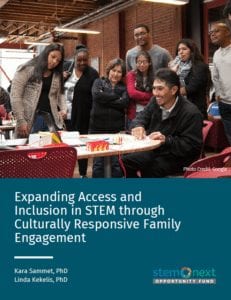 What can we do differently to improve access to and inclusion in STEM? Include families! The research is clear and consistent: Families are among the biggest influence on youth outcomes, including in STEM, and especially for girls. Importantly, families don’t need to be STEM experts themselves or to have a STEM background in order to support youth in STEM. Informal STEM programs are perfectly placed to support parents and caregivers to encourage, broker and navigate.
What can we do differently to improve access to and inclusion in STEM? Include families! The research is clear and consistent: Families are among the biggest influence on youth outcomes, including in STEM, and especially for girls. Importantly, families don’t need to be STEM experts themselves or to have a STEM background in order to support youth in STEM. Informal STEM programs are perfectly placed to support parents and caregivers to encourage, broker and navigate.
Culturally responsive family engagement is both a strategy and a process that maximizes the unique strengths, interests, needs, and complexities of communities who are underrepresented in STEM. As an approach to equitable and inclusive education, culturally responsive STEM is sensitive to the historical disparity of power and privilege between providers and program participants, particularly with respect to cultural differences across race, language, religion, geography, language and nationality. Why is it important? Culturally responsive family engagement intentionally taps into family culture and history to develop curriculum that is engaging and meaningful.
In this Case Study, Drs. Sammet and Kekelis highlight best practices and lessons learned from two programs – Techbridge Girls and Code Next – that serve communities with important cultural differences across race/ethnicity, religion, geography, language and immigration status. This case study offers insights for both practitioners and funders of STEM programs.

